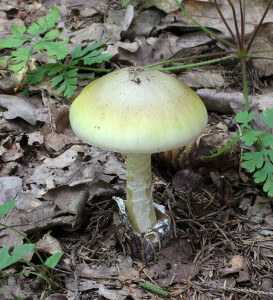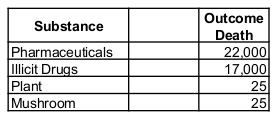UPDATE: Newer Information is Available
Updated information can be found in our latest article reviewing statistics of foraging related deaths.
Article Summary
According to the AAPCC (American Association of Poison Control Centers) annual report(which only includes cases in their system): 1 person died from a poisonous mushroom and 2 people died from poisonous plants in 2010. The numbers increased in 2011 and in 2012 they have on record that 7 people died from poisonous mushrooms and 2 people died from poisonous plants. These numbers only include cases in their system which requires a call to one of their poison control centers. Although this is often quoted as the actual number of people who died from plants and mushrooms it is likely higher based on the fact that not all cases of plant or mushroom poisoning in the united states are identified as such and reported to the AAPCC.
How much higher is the actual number from the recorded number? It is impossible to determine for sure. This article contains one way of estimating based on the accuracy of other categories that the AAPCC reports on.
The next article in this series will analyze the available data to determine which plants and mushrooms cause the most recorded deaths. This article is currently in the process of being written, click HERE to be notified when it and other new articles get published on Eat The Planet.
What This Article Will Cover

The intent of this article is to explore the question: How many people die from foraging plants and mushrooms in the United States each year? This article also discusses how those figures compare to other causes of death in the United States such as: acute poisoning from pharmaceuticals and illicit drugs. This information should put into perspective any concerns people may have about foraging for wild edibles and medicinal herbs.
An Initial Review of The Recorded Data
We chose to feature data from the year 2010 because there seems to be a sufficient amount of data for that year to make good comparisons. It is worth noting that in 2012 the number of recorded fatalities according to AAPCC (American Association of Poison Control Centers) from plants and mushrooms were 3 times what they were in 2010. The summarized data for 2010, 2011 and 2012 can be seen by clicking HERE.
The AAPCC (American Association of Poison Control Centers) issues a report annually that contains information on the outcome of all cases of poisoning that have gone through their system, but only cases that have gone through their system which requires a call to one of their poison control centers. Their system does not include all actual cases in the United States. It is impossible to determine the number of actual cases of poisoning from plants or mushrooms because no public source holds that information. We know that for other categories such as deaths from acute pharmaceutical poisoning in 2010 the AAPCC only has cases on about 2% of the estimated number of actual deaths which are presented on DrugWarFacts.org . Figure 1 shows the number of cases and their outcomes that have gone through the AAPCC system for 2010.

Best Estimate for Actual Instances of Death Due to Poisoning From Plants and Mushrooms Annually
The AAPCC information states that in total their system only recorded 3 deaths from plant and mushroom poisoning in 2010. That is probably not the total number of actual deaths from plants and mushrooms. It is only the number of cases in their system that lead to death, the number of actual cases would be somewhat higher. Since the AAPCC only contains about 2% of fatalities from acute pharmaceutical poisoning. We can assume that it contains a fraction of the actual fatalities from Plant and Mushroom Poisoning as well. It is possible that the AAPCC system is more likely to get contacted in the case of plants and mushrooms because other sources such as doctors and hospitals may not have as much expertise dealing specifically with plant and mushroom poisoning. So lets bump up the estimated percent of cases that the AAPCC recorded and assume that the AAPCC report contains 5% of the total number of actual instances of plant and mushroom poisoning in the United States. Figure 2 shows an estimate of the actual number of fatalities from plant and mushroom poisoning based on the assumption that the previous chart from AAPCC is only 5% of the actual numbers.

Figure 2 above shows estimated numbers around 60 deaths in 2010 from plant and mushroom poisoning. This is purely speculation and many people feel that the number is closer to the AAPCC’s number of less than 10 each year. In 2012 the AAPCC report showed 3 times the numbers that it did in 2010(CLICK HERE to see these numbers), this is probably due to better reporting to the AAPCC but possibly it is due to more poisonings because of an increase in foraging. With all these variables in mind we come to the conclusion that there are somewhere between 10 and 60 total fatalities due to plant and mushroom poisoning annually in the United States. Exactly where the number lies is impossible to determine. If the AAPCC is indeed recording close to 100% of all cases than it will be closer to 10, but if the AAPCC is only recording a fraction of the real number of cases like it is for many of its other categories then the number would be higher.
Comparison of Deaths From Other Causes
Wild edibles and medicinals are harvested primarily for those two reason: food, and medicine, but sometimes as recreational drugs. Now we will compare the number of deaths from plants and mushrooms to the number of deaths from acute poisoning from pharmaceuticals and illicit drugs. Figure 3 shows a comparison of numbers that fit within our estimated deaths due to plant and mushroom poisoning compared to round numbers of deaths from illicit drugs and pharmaceuticals annually which is posted on DrugWarFacts.org and similar numbers are confirmed by the CDC in other years.

Is Foraging for Wild Edibles Dangerous?
As the Figure above shows acute poisoning from pharmaceuticals is more than 400 times more likely than deaths from plants and mushrooms. A very important factor has not been discussed yet in this article and that is that nearly all the recorded deaths from plants and mushrooms are from species known to be lethal in even small doses. All edible plants and mushrooms are visually distinguishable from poisonous ones if you know what to look for. Sometimes there are small nuances that distinguish them but the characteristics are there. Fatalities from plants and mushrooms can be lowered by educating people on proper identification. Mankind has been safely foraging for plants and mushrooms since the beginning of our existence, so it’s clear that we have the ability to differentiate plant and mushroom species when we correctly learn what to look for, and spend time honing our identification skills. Is foraging for wild edibles dangerous? NO, not as long as your sure your eating a wild EDIBLE and not a POISONOUS look-a-like.
Which Species Cause the Most Deaths and Why?
The next article in this series will analyze the available data primarily from the AAPCC to determine which plants and mushrooms cause the most recorded deaths and which ones have the potential to. This article is can be found HERE.
Many of our readers find that subscribing to Eat The Planet is the best way to make sure they don't miss any of our valuable information about wild edibles.
See our privacy policy for more information about ads on this site







2 Responses
Thank you for sharing and spreading awareness! This article would help new mushrooms enthusiasts how to spot an edible mushroom from the deadly ones especially for people who would love to hunt mushrooms in the wild
This is a great help to those people who goes mushroom picking. It is really necessary to know the difference of edible mushrooms and the poisonous one.